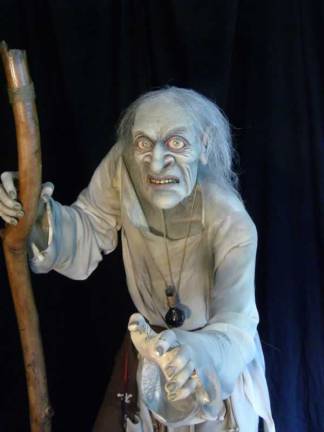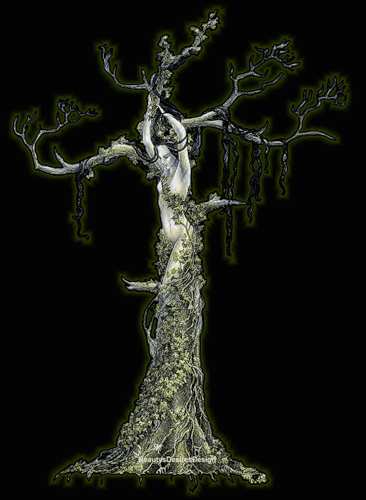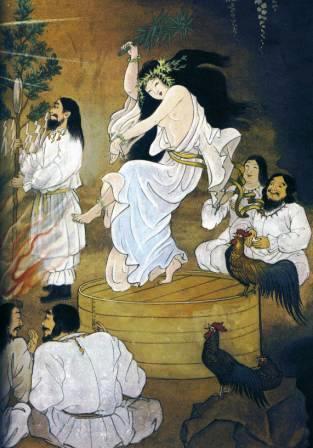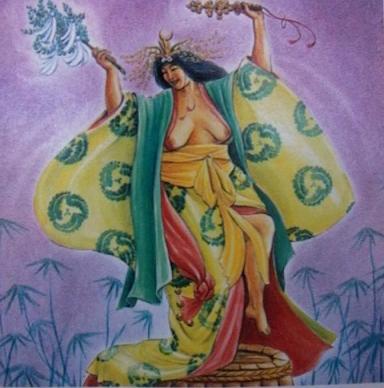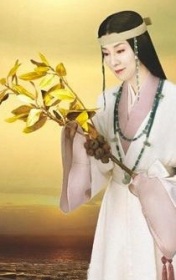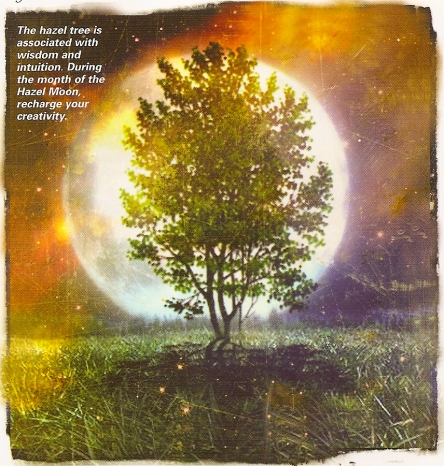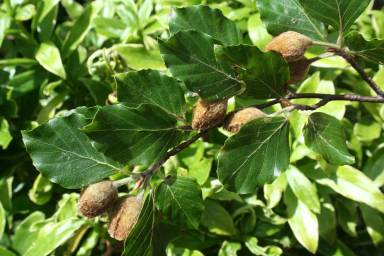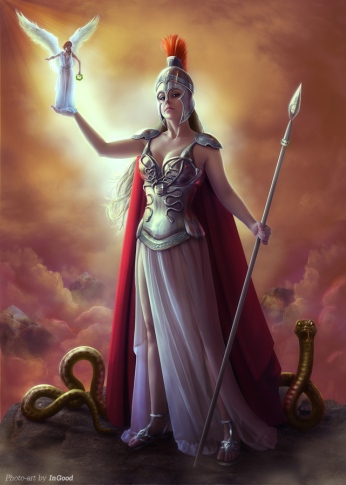“Holda’s themes are longevity, wisdom, kinship, magic, destiny and karma. Her symbols are white items and aged items. Among the Teutons, Holda is known as the White Lady, an appellation that alludes to the color of Her hair. This Goddess is the wise, ancient crone, who has learned the lessons of destiny and karma from a long, well-lived life and who bears the knowledge of magic’s deeper mysteries to us with patience and time.
In Massachusetts, the first Sunday in October is set aside to honor grandparents and their vital role in families. Customarily, grandparents (or ‘adopted’ ones) are invited for dinner and showered with attention. I think this is a lovely tradition as it stands, honoring Holda’s wisdom through the elders in our community. Go to a nearby nursing home and spend half an hour or more cheering up someone. Listen to people’s stories of days gone by, and let their insights inspire you.
To improve your own awareness of karmic law, or to increase your magical insights, wear Holda’s white (a scarf on your head would be good) or carry a white stone with you to represent Her (coral is ideal, being a stone of wisdom). Alternatively, eat some aged cheese or drink aged wine to remind yourself that ‘old’ doesn’t mean outmoded. People can become better with time and with Holda’s guidance, if we remember to appreciate the years and the people who have gone before us on this path.”
(Patricia Telesco, “365 Goddess: a daily guide to the magic and inspiration of the goddess”.)
There was a ton of information on Holda to go through! She turns out to be a very interesting and complex and all encompassing Goddess; seen as the maiden in summer sitting by a lake combing Her beautiful white hair; as mother who made the fields, animals and women fertile and protected women and children, as well as accompanying those infants who had died before they’d been named to the Other World; and as wizened crone in the winter who was stern and despised laziness. She also had connections with many different Goddesses, both within the Germanic and Norse pantheons and even outside: Goddesses to include Freya due to Her association with cats (appaerntly the name of the cave She lived in, Kitzkammer means ‘Cat Chamber’) and Frigga for Her associations with the household, women, spinning and children; Perchte and Berchta (which appears to be debatable to some as to whether they were the same Goddess or entirely different Beings with similar attributes); and later in post-Christian times, even Diana and Habondia as She was demonized and said to lead “a wild hunt in which She led the souls of infants who died unbaptized, witches, and heathens in general.” [1]
In a paper written by SummerGaile, she explains that: “In Jacob Grimm’s Teutonic Mythology, Holda is spoken of as host to the Wild Hunt or ‘Wilde Heer’. In this account She is the consort of Woden, supreme god of the Germanic tribes occupying central Europe in ancient times. There are many variations of this story, but the themes that are most prominent are the ones that illustrate Holda leading a Wild Hunt to gather those souls that may still be lingering earth bound; and it is She who gathers them during this ride to usher them into the Other World. Another variation of this record is that She gathers un-baptized children, or more accurately, she gathers those born and who died without having been given a birth name, and takes them safely to the Other World.” [2] Due to Her connections with death, magic and witches, She is also sometimes associated with Hecate and Hel.
And of course, in the post-Christian times as we see with many independent mother Goddesses, She is transformed from Mother Holda, or “Gracious One” who helped and protected women and children into the “Goddess of the Witches” – an old ugly hag who rode a broom across the night sky; as well as many of Her symbols taking on new evil attributes: “No where is this demonization more clear than in ‘Sleeping Beauty’ where the spinning wheel and spindle are turned into symbols of evil. Many of Her other attributes were turned around as well. Her protection of the dead soul of infants was turned around to Her creeping in and stealing children from their cradles. Her image as wise old woman, instilling moral values turned to the foolish old Mother Goose who spreads wives tales.” [3]
“Throughout German, Austrian and Swiss folktales we find this former Goddess demoted, together with Her twin Perchta, to a witch. Frau Holle was the more pleasant of the two: sunshine streamed from Her hair when She combed it, snow covered the earth when She shook a feather comforter, and rain fell when She threw away laundry water. She was a splendid white lady who appeared each noon to bathe in the fountain, from which children were said to be born. She lived in a cave in the mountain or in a well, and people could visit Her by diving into it.
She rode on the wind in a wagon. Once She had to have a broken lynchpin repaired, and the man who helped Her later found that savings of wood from the project had fumed to gold. In addition to gold, She rewarded good people with useful gifts, such as the invention of flax and spinning.
Her feast day was celebrated on winter solstice, when She checked the quality of each spinner’s work. A good spinner would wake to find Frau Holle had left her a single golden thread, but sloppy ones found their work tangled, their spinning wheels shattered or burnt.
The period between December 25 and January 6 – the ‘twelve days of Christmas’ – were sacred to Frau Holle during that time She traveled the world in Her wagon. No rotary actions were allowed; sleighs were used instead of wagons, and all meal-grinding had to cease. Her twin Perchta was, if not welcomed, at least acknowledged at the same season” (Monaghan, p. 127).
Correspondences
Other Names: Frau Holda, Frau Holle, Winter Goddess, White Lady, Mother Yule, Hulde
Attributes: Virtue, Motherhood, Wisdom
Season: Winter, Yule
Symbols: Spindle, Spinning Wheel, Flax, Geese, Apples, Milk, Elder Tree, Elderberry Tea
Colors: White, Ice Blue
Symbols: Snow, Snowflakes, Well [4]
Sources:
Eaves, Susan “Ratatask”. Eplagarthrkindred.org, “HoldaArticle“.
Monaghan, Patricia. The New Book of Goddesses and Heroines, “Frau Holle”.
Paxson, Diana L. Hrafnar.org,”Holda“.
SummerGaile. Order of the White Moon, “The Sacred Journey and Migration of Frau Holda Into our Modern Reality“.
Zmaj, Majka. Order of the White Moon, “Holda: White Lady of Winter“.
Suggested Links:
AOR, Thorsigurd. Odinic-rite.org, “Holda“.
Finnegan, Margaret. Margaretfinnegan.blogspot.com, “Goddess of the Week: Holda“.
Fox, Selena. Beliefnet.com, “Riding with Holda“.
Dashu, Max. Suppressedhistories.net, “The Old Goddess“.
GardenStone. Goddess Holle: In Search of a Germanic Goddess.
Glaux. Afwcraft.blogspot.com, “Faces of the Golden Queen“.
Graves, Shannon. Northernpaganism.org, “Who is Holda?”
Motherholda.blog.com, “Holda”
Linda-heathenycatmusings.blogspot.com, “H is for the goddess HOLDA – Ancient Lady of the Sacred Land, Queen of the ‘other folk’“.
Marks, Dominic. Lowchensaustralia.com, “Norse Goddess Names“.
Motz, Lotte. Winterscapes.com, “The Winter Goddess: Percht, Holda, and Related Figures“.
Theoddgods.com, “Perchta/Berchta“.
Seigfried, Karl E. H. Norsemyth.org, “THE GODS & GODDESSES, Part Two“.
Swampy. Dutchie.org, “Goddess Berchta“.
Wikipedia, “Holda“.




